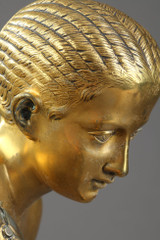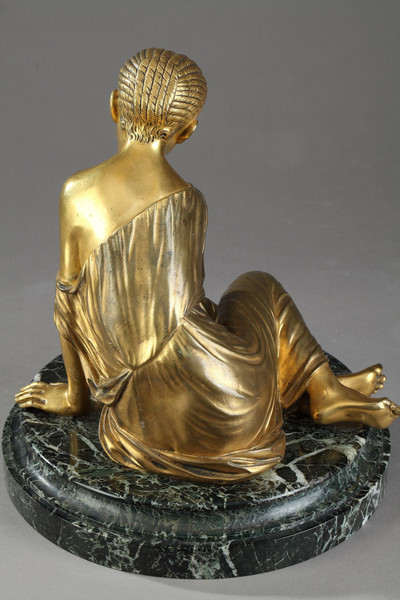A gilt bronze sculpture depicting a young girl wearing a chiton, playing knucklebones. It rests on a circular base of molded Vert de Mer marble. Minor wear to the gilding. Often attributed to Pradier (1790-1852), "The Knucklebone Player" is in fact a copy of the famous antique statue of the same title discovered by Vigna Giustiniani in 1732, now in the Pergamon Museum in Berlin. A cast of this statue, made at the French Academy in Rome, served as a model for several artists who stayed at the Academy, including Claude Francin and Augustin-Félix Fortin. Etienne Parrocel (1696-1776) also made a drawing after the antique sculpture around 1732, which is listed in the Joconde database and held at the Louvre Museum. The meaning of these knucklebones, undoubtedly symbolic and reflecting new customs or beliefs in ancient Greece, may also have contributed to their rapid spread. The element of chance at play here refers to destiny and the gods who preside over it. For a young girl destined for the role of wife, this meant entrusting herself to Aphrodite, a deity of increasing importance from the 4th century BC onward. Thus, the "Aphrodite throw," where each knucklebone lands on a different face, was the best throw. Similarly, a young girl awaiting marriage could be called philastragale, meaning "loving knucklebones." Placed in the tomb of a young girl, the figurine could therefore symbolize the thwarted destiny of the future bride, who died prematurely. Offered as a votive offering in a sanctuary, it could likewise underscore the transition from adolescent to married woman. The presence of genuine knucklebones, sometimes found in impressive numbers in certain tombs or sanctuaries, confirms the symbolic value of these game pieces. Bibliography: Joconde database. Period: Late 19th century, Circa: 1880. Dimensions: L: 27cm, W: 27cm, H: 30cm.
- Reference :
- 2232
- Availability :
- Sold
- Width :
- 27 (cm)
- Height :
- 30 (cm)
- Depth :
- 27 (cm)
- Identify Exists:
- False
























